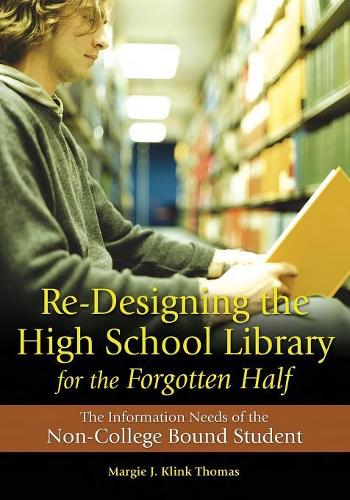
Re-Designing the High School Library for the Forgotten Half: The Information Needs of the Non-College Bound Student
(Paperback)
Publishing Details
Re-Designing the High School Library for the Forgotten Half: The Information Needs of the Non-College Bound Student
By (Author) Margie J. Klink Thomas
Bloomsbury Publishing PLC
Libraries Unlimited Inc
30th September 2008
30th September 2008
United States
Classifications
Professional and Scholarly
Non Fiction
027.82230973
Physical Properties
Paperback
88
Width 178mm, Height 254mm
198g
Description
Most high school administrators, teachers, and staff concentrate on the student who is in the college preparatory track, while those who may not even finish high school have less attention paid to their curriculum and their educational needs. If the role of the school librarian is to prepare all students for lifelong learning, school librarians must work closely with teachers in charge of courses preparing students to go from school to work. They need to remind other teachers who are in general courses that many of the students in their classrooms who will not go to college, but will take jobs which pay them much more than the college graduate makes in many areas of the work force. This book points out the role of the school librarian in working with aIl the students and maps out the route to take to make this happen.
Reviews
This thoroughly user friendly instructional guide should be a part of every college and university's Library Science reference collection and supplemental reading list. * Midwest Book Review/Library Bookwatch *
This book will serve as a valuable resource for those seeking to address the needs of these sometimes-over-looked students. * VOYA *
Thomas strongly advocates involvement by school librarians in the educational reform recommended and currently taking place in many schools across the country. In the first chapter, she examines the history behind educational changes in high schools and libraries during the 20th century and looks at numerous papers, reports, and research results and addresses the role of school libraries in Career Technical Education programs. Emphasis is placed on this relationship and frequently stressed throughout the book and is in response to a lack of background in this area for librarians. Further chapters zero in on some of the reform models being used and promoted, the importance of librarians collaborating with teachers in CTE programs, taking a positive look at meeting the needs of all students and programs, examining the role of the school librarian in school reform measures, and integrating literacy and research skills. The author discusses providing valuable library resources through awareness of program needs, selling the library to all students and faculty, and, finally, taking the steps to investigate and understand these changing needs. Each chapter concludes with an extensive reference list, with Web site addresses for many resources, papers, and programs mentioned. Copious statistics, charts, graphs, figures, etc., support the book's thesis. An invaluable resource and instructional guide. * School Library Journal *
Any school librarian in a school where a large number of students graduate and move directly into the work place would benefit from the purchase of this comprehensive guide to serving the needs of the 'forgotten half' of the student body. * Catholic Library World *
. . . provides a solid overview for those entering the field and school librarians not already collaborating with all their colleagues. * Library Media Connection *
Author Bio
Margie J. Klink Thomas has been a librarian in special, academic, and public libraries as well as her last position as a high school librarian in Fairbanks, AK. She is a doctoral graduate of Florida State University.
